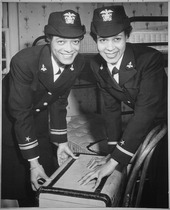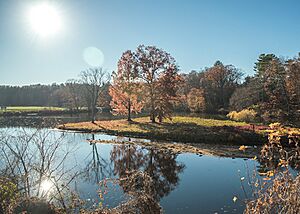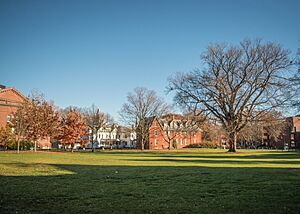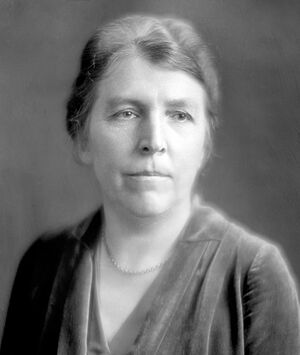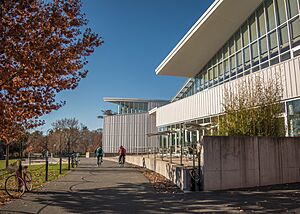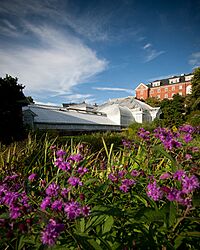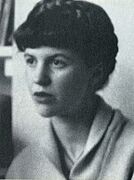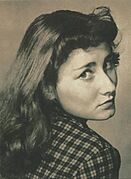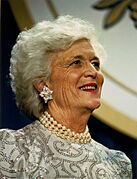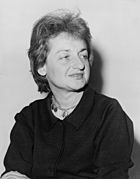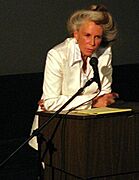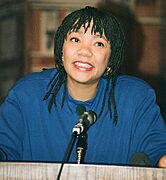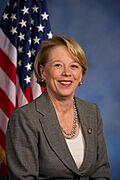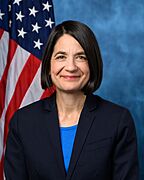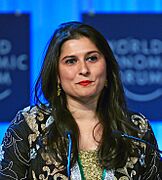Smith College facts for kids
 |
|
| Motto | Ἐν τῇ ἀρετῇ τὴν γνῶσιν (Greek) |
|---|---|
|
Motto in English
|
To Virtue, Knowledge (2 Peter 1:5) |
| Type | Private liberal arts women's college |
| Established | 1871 (opened 1875) |
| Accreditation | NECHE |
|
Academic affiliation
|
|
| Endowment | $2.4 billion (2022) |
| President | Sarah Willie-LeBreton |
| Provost | Daphne Lamothe |
|
Academic staff
|
285 |
| Students | 2,873 (2022–23) |
| Undergraduates | 2,523 (2022–23) |
| Postgraduates | 401 (fall 2018) |
| Location |
,
U.S.
42°19′3″N 72°38′15″W / 42.31750°N 72.63750°W |
| Campus | Small-town |
| Colors | Blue with gold trim |
| Nickname | Smith Bears |
|
Sporting affiliations
|
NCAA Division III – NEWMAC |
Smith College is a private college for women in Northampton, Massachusetts. It was started in 1871 by Sophia Smith and opened in 1875. Smith College is part of the historic Seven Sisters colleges. This is a group of women's colleges in the Northeastern United States.
Smith is also part of the Five College Consortium. This group includes Mount Holyoke College, Amherst College, Hampshire College, and the University of Massachusetts Amherst. Students can take classes at any of these colleges. On campus, you can find the Museum of Art and the Botanic Garden. The famous landscape architect Frederick Law Olmsted designed the garden.
Smith has 50 different subjects and programs. Students take a writing class in their first year. They also choose a main subject to study. Smith was the first women's college to offer an engineering degree. Smith's sports teams are called the Smith Bears. It was the first women's college to join the NCAA.
Many famous people have graduated from Smith. These include authors, journalists, and politicians. Two First Ladies of the United States also went to Smith.
College History
Early Beginnings
Smith College started in 1871. It was funded by Sophia Smith. She left her money to create a college for women. She wanted women to have the same education as men. The college opened in 1875 with 14 students and 6 teachers.
In the 1890s, the campus was designed as a botanical garden. Frederick Law Olmsted planned the beautiful grounds. By 1915, there were 1,724 students and 163 teachers.
In the 1920s, two students went missing. Alice Corbett disappeared in 1925 and was never found. Frances Smith disappeared in 1928.
By 2010, the school had 2,600 students on campus. The campus is 147 acres. It has over 1,200 types of trees and shrubs. Smith is the largest private college for women in the United States.
Training During World War II
During World War II, Smith College helped train women for the Navy. The United States Naval Reserve Midshipmen's School was at Smith. It was called "USS Northampton." On August 28, 1942, 120 women started training there.
Recent Events
In April 2015, the college decided to make its research available online for free. This is called an open-access policy.
On September 15, 2022, Sarah Willie-LeBreton was chosen as the 12th president. She started her role on July 1, 2023.
College Presidents
Smith has had 11 presidents and two acting presidents. Elizabeth Cutter Morrow was the first woman to lead the college. She was an acting president. Since 1975, most Smith presidents have been women.
| No. | Image | President | Term start | Term end | Refs. |
|---|---|---|---|---|---|
| 1 |  |
Laurenus Clark Seelye | 1875 | 1910 | |
| 2 |  |
Marion LeRoy Burton | 1910 | 1917 | |
| 3 |  |
William Allan Neilson | 1917 | 1939 | |
| acting |  |
Elizabeth Cutter Morrow | 1939 | 1940 | |
| 4 |  |
Herbert Davis | 1940 | 1949 | |
| 5 |  |
Benjamin Fletcher Wright | 1949 | 1959 | |
| 6 |  |
Thomas Corwin Mendenhall | 1959 | 1975 | |
| 7 |  |
Jill Ker Conway | 1975 | 1985 | |
| 8 |  |
Mary Maples Dunn | 1985 | 1995 | |
| 9 |  |
Ruth Simmons | 1995 | June 2001 | |
| acting |  |
John M. Connolly | June 2001 | May 31, 2002 | |
| 10 |  |
Carol T. Christ | June 1, 2002 | June 30, 2013 | |
| 11 |  |
Kathleen McCartney | July 1, 2013 | June 30, 2023 | |
| 12 |  |
Sarah Willie-LeBreton | July 1, 2023 | Present |
Campus Life
Green Campus Efforts
Smith College works to be environmentally friendly. They have a program with Zipcar to reduce cars on campus. The college also teaches about sustainability in classes and through art.
Smith earned a good grade for its sustainability efforts in 2010. It was praised for student involvement and green buildings.
Academics and Learning
Smith College has 285 professors. They teach in 50 different subjects. There is one teacher for every nine students. Smith was the first women's college to offer an engineering degree. The Picker Engineering Program offers a special Bachelor of Science degree. It combines different engineering fields.
In 2008, Smith made the SAT optional for applying. This means students do not have to submit SAT scores.
Smith has its own study abroad programs. Students can study in Paris, Hamburg, Florence, and Geneva. They must speak the local language in these programs. Almost half of Smith's junior students study overseas.
The Center for Women in Mathematics invites math students from other colleges. They can study at Smith for one year. This program helps young women improve their math skills. It also offers a year of math study for women who did not major in math.
The Louise W. and Edmund J. Kahn Liberal Arts Institute supports research. It helps teachers and students work together on projects. Students become Kahn Fellows. They work with teachers and visiting experts for a year.
Students can learn leadership skills through the Phoebe Reese Lewis Leadership Program. They practice public speaking and teamwork.
Smith's internship program is called "Praxis: The Liberal Arts at Work." All students can get one college-funded internship. This helps students find interesting jobs in many fields.
The most popular subjects for students who graduated in 2021 were:
- Research & Experimental Psychology (49 students)
- Biology/Biological Sciences (48 students)
- Political Science & Government (45 students)
- Engineering Science (36 students)
- History (30 students)
- English Language & Literature (25 students)
- Mathematics (23 students)
- Economics (23 students)
- Computer Science (22 students)
Ada Comstock Scholars Program
The Ada Comstock Scholars Program is for students who are not typical college age. These are women from their mid-twenties to over sixty. About 100 women are in this program. They take the same classes as other students. They can study full-time or part-time. They can live on or off campus. Financial help is available for those who need it.
This program started in 1968. It became official in 1975. It is named after Ada Louise Comstock Notestein. She graduated from Smith in 1897. She was a professor and dean at Smith. She also became president of Radcliffe College. She believed in education for women throughout their lives.
Graduate Studies
Smith offers several advanced degrees. These programs accept applicants of any gender. Degrees include Master of Arts in teaching and Master of Science in biological sciences. They also offer Master and Ph.D. degrees in social work. About 100 men and women study for advanced degrees at Smith each year.
The Smith College School for Social Work is known for its clinical social work program. It focuses a lot on real-world experience. The school offers a Master of Social Work (M.S.W.) degree. It also has a Ph.D. program for social workers.
Smith is part of a special doctoral program. It works with Amherst College, Hampshire College, Mount Holyoke College, and the University of Massachusetts Amherst.
Admissions and Rankings
Applying to Smith
The U.S. News & World Report ranked Smith as 'most selective' in 2022.
For the class entering in fall 2023, Smith received 9,868 applications. They accepted 1,875 students (19%). 630 students enrolled. The number of applications increased a lot. This is because Smith decided to offer "loan-free" financial aid. The middle 50% of SAT scores for enrolled students was 670–750 for reading and 670–770 for math. For the ACT, the middle 50% score was 31–34. The average SAT score for Smith College is 1430.
College Rankings
| USNWR Liberal Arts College | 14 |
|---|---|
| Washington Monthly Liberal Arts | 23 |
| Forbes | 135 |
U.S. News & World Report's 2025 rankings placed Smith tied for 14th among liberal arts colleges. It was also ranked 24th for "Best Value." Smith was tied for 15th in "Best Undergraduate Engineering Program." It was also 21st in "Best Undergraduate Teaching."
In 2025, Forbes ranked Smith 135th overall among colleges. Kiplinger's Personal Finance placed Smith 16th for best value liberal arts colleges in 2019. For 2020, Washington Monthly ranked Smith 23rd among liberal arts colleges. This ranking looks at how colleges help the public good. Smith College is officially approved by the New England Commission of Higher Education.
College Traditions
Living on Campus
Smith requires most students to live in campus houses. This helps students feel connected. Smith College does not have typical dorms. Instead, it has 41 separate houses. These houses have different architectural styles. It is said that Chapin House inspired the Tara Plantation House in Gone with the Wind. Author Margaret Mitchell lived in Chapin House for one year.
A fun tradition is eating Sophia Smith's molasses cookies. These are often served at Friday afternoon tea. Students, teachers, and staff gather for tea in each house.
There are two cultural spaces for students of color. These are the Mwangi Cultural Center and Unity House. Mwangi opened in 1968. It was renamed after Dr. Ng’endo Mwangi, a Smith graduate. Unity House is home to 11 cultural organizations.
Two newer buildings are the Julia McWilliams Child '34 Campus Center and the Olin Fitness Center. These buildings help build a sense of community.
In 2009, Ford Hall was finished. It is a new science and engineering building. It helps students and teachers work together across different subjects.
The campus also has a botanic garden. It has special gardens and old glass greenhouses.
In 2018, students protested after an employee called the police on a Black student. The student was working in a common space. Students organized protests and walked out of a college event. Smith investigated and found no bias. Smith then held an Inclusion and Diversity Conference. Students continued to protest about other issues. Smith responded by creating a working group. They also improved the Office of Equity and Inclusion.
In 2020, a former employee, Jodi Shaw, spoke about diversity training. She said it created a bad environment for staff. Smith College President Kathleen McCartney said these claims were false. The New York Times reported on the tensions.
Campus Houses
Smith College has many houses for students to live in. Each house has its own student government. Students can stay in the same house for four years. They can also move to different houses. In 2019, the college changed how it groups houses. They are now in four neighborhoods: Ivy, Paradise, Mountain, and Garden.
Green Street Houses
- Hubbard House – This house is where the fictional President Selina Meyer lived in the TV show Veep. Julia Child lived here too.
- Lawrence House – Sylvia Plath lived in this house.
- Morris House – Built in 1891. Named after Kate Morris Cone.
- Tyler House – Named after William Seymour Tyler, an early college trustee. Former First Lady Barbara Bush lived here.
- Washburn House – Named for former trustee William B. Washburn. During World War II, it was a Spanish-speaking house.
- 44 Green Street
- 54 Green Street
Center Campus Houses
- Cutter House
- Chapin House – Author Margaret Mitchell lived here. Its staircase inspired the one in Gone With the Wind.
- Haven/Wesley Houses
- Hopkins House
- Park Complex
- Park Annex – One of two new houses for minority groups.
- Sessions Complex – The oldest house on campus. It has a secret passageway.
- Tenney House
- Ziskind House
Upper Elm Street Houses
- Capen House – Built in 1825. It became part of the college in 1921. Named after Bessie Talbot Capen.
- Gillett House – Connected to Northrop house. It has the only vegan/vegetarian dining hall.
- Lamont House – Built in 1955. Named for Florence Corliss Lamont, a generous alumna.
- Northrop House
- Parsons Complex
- Parsons Annex – Another new house for minority groups.
- Talbot House – Built in 1909. US First Lady Nancy Reagan lived here. Named for Bessie Talbot Capen.
Lower Elm Street Houses
- Albright House
- Baldwin House – U.S. Senator Tammy Baldwin lived here.
- Chase House – Was a school for girls. Now a substance-free residence. Named after Mary Ellen Chase, a writer and professor.
- Conway House – For Ada Comstock Scholars and their families. Named after Smith President Jill Ker Conway.
- Duckett House - Built in 1803. It is one of the oldest and smallest houses. Residents are called "Ducks." Named for Eleanor Duckett, an English professor.
- 150 Elm Street
East Quadrangle Houses
- Cushing House – Named for math professor Eleanor P. Cushing. Gloria Steinem lived here.
- Emerson House
- Jordan House – Built in 1922. Named for Mary Augusta Jordan, an English professor.
- King House – Named for Franklin King, who worked at Smith for 50 years.
- Scales House - Named after Laura Woolsey Lord Scales, the college's first dean of students.
West Quadrangle Houses
- Comstock House – Named after Ada Comstock.
- Gardiner House
- Morrow House – Named after Elizabeth Cutter Morrow, a former acting president.
- Haynes House - Renamed in 2024 after mathematician Euphemia Haynes.
- Wilson House – Named after Martha Wilson.
- Paradise Apartments – Each complex is named after a notable Smith Alum.
Campus Stories
Smith has many old stories and ghost tales. It was named the most haunted college in America. One story is about Sessions House. It is said to be haunted by Lucy Hunt. She died of a broken heart. People have reported seeing her ghost in the staircase.
Clubs and Sports
Smith has over 120 clubs and organizations. It also has 11 varsity sports teams.
Athletics
From 1986, Smith's teams were called the Pioneers. This name showed the spirit of Smith students. It also showed the college's leading role in women's sports. The first women's basketball game was played at Smith in 1893.
In December 2008, a new logo was revealed. It was to show spirit for Smith's sports teams. Smith was the first women's college to join the NCAA. Smith athletes won early national tennis championships.
On May 7, 2025, Smith changed its mascot. The Smith Bears became the new mascot. This change honors Senda "the Bear" Berenson. She is famous for her work in basketball.
Smith College's official color is white with gold trim. But the college logo is blue and yellow. Sports teams often use blue and white or blue and yellow uniforms. Club sports can choose their own colors.
Smith has a system of class colors. These colors date back to the 1880s. Today, class colors are yellow, red, blue, and green. New students get the color of the graduating class. This color stays with them until they graduate.
Cultural Groups
There are 11 cultural organizations at Smith. They are part of the UNITY group. These include the Asian Students’ Association (ASA) and Black Students’ Alliance (BSA). Other groups are for Chinese, South Asian, Indigenous, International, Korean, Latin American, Multiethnic, Caribbean, and Vietnamese students. The Black Students’ Alliance is the oldest of these groups. In 2012, the Weaving Voices Archives Project started. It documents the history of students of color at Smith.
Yearly Events
Convocation starts the fall semester. It is a chance for new students to see Smith's traditions. Students wear creative outfits. Seniors wear special "senior hats" for the first time.
Mountain Day happens early in the fall. The college president chooses a sunny autumn day. Classes are canceled. Bells ring on campus at 7:15 AM to announce it. Students often go on trips or do outdoor activities. The college provides packed lunches. Many houses go apple-picking. Students often wear flannel on Mountain Day.
Cromwell Day is named for Otelia Cromwell. She was Smith's first African-American student. Her niece, Adelaide Cromwell, was Smith's first African-American faculty member. This day started in 1989. It focuses on issues of racism and diversity. Afternoon classes are canceled. Students attend talks and workshops.
Rally Day started in 1876. It was a celebration of George Washington's birthday. In 1894, a "rally" became part of the day. The focus became more patriotic. In 1906, it was first called Rally Day. In 1944, seniors wore their graduation caps and gowns for the first time. Today, students wear funny, homemade hats. Rally Day has a historical theme. It features a special speaker. Smith College Medals are given to successful alumnae.
Graduation Events
The Alumnae Association of Smith College hosts reunions every five years. All former students are welcome to return any year.
Graduation events celebrate the connection between former students and graduating seniors. After final exams, most younger students leave. Seniors stay in their houses for a week. Former students arrive for reunions. Many stay in the campus houses with the seniors.
Ivy Day is the day before graduation. It is a big event for seniors. Younger students lead a parade. They carry ivy vines. Seniors plant the ivy as a symbol of their connection to the college. Former students, dressed in white, line up. They wear sashes in their class color. Seniors wear white and carry a red rose. Everyone cheers for each class. The parade ends in the Quad. Seniors plant their ivy. Speakers talk about the college.
Illumination Night starts at dusk the night before graduation. It celebrates the campus. Electric street lights are replaced by colorful paper lanterns. These lanterns have real candles. Student singing groups and comedy groups perform. A jazz band plays for dancing. Seniors, former students, and families walk around the illuminated campus. The main event is the Senior Step Sing. Seniors gather on the library steps. Younger students sing to them. Then, the seniors are gently pushed off the stairs. This symbolizes them going "into the real world."
Until the early 1990s, all reunions were held during graduation weekend. But too many people came. So, reunions were split into two weekends.
Notable Alumnae
-
Pulitzer Prize-winning writer Margaret Mitchell
-
Pulitzer Prize-winning writer Sylvia Plath
-
Chef and television personality Julia Child
-
Feminist activist Betty Friedan
-
Feminist activist Gloria Steinem
-
Feminist and legal scholar Catharine A. MacKinnon
-
Civil rights activist Yolanda King
-
U.S. Senator for Wisconsin and first openly LGBTQ+ person elected to Congress Tammy Baldwin
-
Former U.S. Congress Member Jane Harman
-
Former U.S. Congress Member Niki Tsongas
-
U.S. Congress Member Becca Balint
-
Academy Awards-winning documentarian Sharmeen Obaid-Chinoy
Here are some notable people who went to Smith College:
- Otelia Cromwell (class of 1900): First African-American graduate of Smith College.
- Blanche Hinman Dow (class of 1913): Former president of the American Association of University Women.
- Clara Savage Littledale (Class of 1913): Writer and editor for Parents magazine.
- Eunice Carter (class of 1921): First female African-American assistant district attorney in New York.
- Margaret Mitchell (class of 1922): Author of Gone with the Wind. She did not graduate from Smith.
- Mary Watson Weaver (class of 1925): Composer and poet.
- Julia Child (class of 1934): Famous chef, author, and TV personality.
- Madeleine L'Engle (class of 1941): Author known for A Wrinkle in Time.
- Betty Friedan (class of 1942): Feminist and author of The Feminine Mystique.
- Nancy Reagan (class of 1943): First Lady of the United States from 1981 to 1989.
- Penny Chenery (class of 1943): Sportswoman and racehorse owner.
- Rhoda Dorsey (class of 1946): Historian and first woman president of Goucher College.
- Barbara Bush (class of 1947): Former First Lady of the United States. She did not graduate from Smith.
- Mary Otis Stevens (class of 1949): American architect.
- Natalie Babbitt (class of 1954): Illustrator and author of Tuck Everlasting.
- Sylvia Plath (class of 1955): Poet, novelist, and short story author.
- Gloria Steinem (class of 1956): Founder of Ms. magazine, feminist, and journalist.
- Lynden B. Miller (class of 1960): Public garden designer and author.
- Jane Yolen (class of 1960): Children's book author.
- Susan Hiller (class of 1961): Conceptual artist.
- Ng'endo (Florence) Mwangi (class of 1961): Kenya's first woman doctor.
- Anne Mollegen Smith (class of 1961): First woman editor-in-chief of Redbook.
- Halina Poświatowska (class of 1961): Polish poet and writer.
- Jane Harman (class of 1966): Former U.S. Representative.
- Molly Ivins (class of 1966): Journalist and political commentator.
- Shelly Lazarus (class of 1968): Former CEO of Ogilvy & Mather.
- Niki Tsongas (class of 1968): Former U.S. Representative.
- Catharine MacKinnon (class of 1968): Legal scholar and activist.
- Laura D'Andrea Tyson (class of 1969): Economist.
- Yolanda King (class of 1976): Activist.
- Christine McCarthy (class of 1977): Chief Financial Officer of The Walt Disney Company.
- Ann M. Martin (class of 1978): Author of The Babysitter's Club.
- Phebe Novakovic (class of 1979): Chairman and CEO of General Dynamics.
- Ruth Ozeki (class of 1980): Author of A Tale for the Time Being.
- Margaret Edson (class of 1983): Winner of a Pulitzer Prize for Drama.
- Tammy Baldwin (class of 1984): United States Senator.
- Tori Murden (class of 1985): First woman to row solo across the Atlantic Ocean.
- Thelma Golden (class of 1987): Director of The Studio Museum in Harlem.
- Nancy La Vigne (class of 1987): Criminologist.
- Durreen Shahnaz (class of 1989): Founder of Impact Investment Exchange (IIX).
- Becca Balint (class of 1990): Current U.S. Representative from Vermont.
- Jennifer Chrisler (class of 1992): Executive director of the Family Equality Council.
- Piper Kerman (class of 1992): Author of Orange Is the New Black.
- Deborah Archer (class of 1993): First Black president of the American Civil Liberties Union (ACLU).
- Kim Janey (class of 1994): First woman and first Black mayor of Boston.
- Hanya Yanagihara (class of 1995): Author and editor.
- Emily W. Murphy (class of 1995): Administrator of the General Services Administration.
- Dorie Clark, (class of 1997): Author and professor.
- Luma Mufleh (class of 1997): Founder of Fugees Family, Inc.
- Cass Bird (class of 1999): Fashion photographer.
- Erin Morgenstern (class of 2000): Author of The Night Circus.
- Sara Haines (class of 2000): Co-host of The View.
- Rubaiyat Hossain (class of 2002): Filmmaker.
- Sharmeen Obaid-Chinoy (class of 2002): Documentarian, winner of two Academy Awards.
- Lydia Jett (class of 2002): Investor and board member.
- Julia Scott (class of 2002): Journalist for NPR and New York Times.
- Kimberly Drew (class of 2012): Art curator and critic.
Notable Staff
- Herbert Baxter Adams (1850–1901): Historian who taught at Smith from 1878 to 1881.
- Newton Arvin: American literary critic.
- Leonard Baskin: Artist who taught at Smith from 1953 to 1974.
- Mary Ellen Chase: Educator and author, taught English from 1926 to 1955.
- Emily Hale: Speech and drama teacher.
- Louise Holland (1893–1990): Archaeologist, taught here from 1957 to 1964.
- Daphne Lamothe: Provost and professor.
- Yusef Abdul Lateef: Jazz musician, taught at Smith in the early 2000s.
- Sylvia Plath (1932–1963): American poet, was an English professor from 1957 to 1958.
- Kurt Vonnegut: Served as Writer-in-Residence during 2000–2001.
- Jane Zielonko: Translator, taught English at Smith from 1946.
In 1960, three Smith professors were fired or retired. This was due to their personal lives. This event was written about in a book and a film. In 2002, Smith recognized this past wrong. They created a lecture series and a scholarship.
See also
 In Spanish: Smith College para niños
In Spanish: Smith College para niños
- Cambridge School of Architecture and Landscape Architecture
- College Archives (Smith College)
- Smith College commencement controversies
- SS Smith Victory – a cargo ship named after Smith College
- Tofu Curtain



